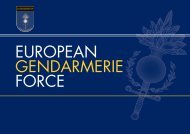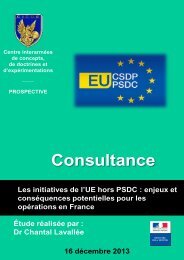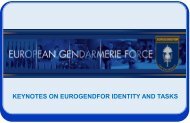Conference
science-research-bulletin-2013-conference
science-research-bulletin-2013-conference
Create successful ePaper yourself
Turn your PDF publications into a flip-book with our unique Google optimized e-Paper software.
EUROPEAN POLICE SCIENCE AND RESEARCH BULLETIN<br />
SPECIAL CONFERENCE EDITION<br />
Declarations of Human Rights and Slovenian<br />
documents related to the protection of minorities<br />
in the country, and a module on the importance<br />
of non-violent conflict resolution skills. In this<br />
module, participants describe a perceived<br />
dilemma about policing in relation to the Roma<br />
minority, followed by a separation of those<br />
things which can be dealt with but the police<br />
and those which cannot, according to Slovenian<br />
law. For example, the problem of Roma driving<br />
without a licence, would be a situation that the<br />
police would be empowered by law to handle<br />
directly. However, infrastructural problems, such<br />
as a settlement which lacks proper sanitation,<br />
could be assisted by the police, but not without<br />
the cooperation of other government agencies.<br />
During the first day of training, there is also a<br />
role-playing exercise in which the police officers<br />
pretend to be a member of the Roma minority<br />
and the trainers act as Slovenian police so that<br />
the police officers can experience the limitations<br />
the Roma may have in getting in contact with<br />
the Slovenian police (Strobl et al., 2013).<br />
The Roma participants are brought into the<br />
training on the second day. Because the training<br />
is joint in nature, Roma leaders, whether from<br />
the Roma Union of Slovenia (for more see www.<br />
zveza-roma.si) or the Forum of Roma Councillors<br />
(for more see www.romsvet.si), are brought<br />
into this stage of the seminar in order to initiate<br />
cooperation between the local police and Roma<br />
in a direct way. On this day, another role-playing<br />
occurs during which two teams debate each other<br />
over a local issue, with one team representing the<br />
Slovenian majority and the other representing<br />
the Roma community. The actual make-up of the<br />
groups is heterogeneous as to whether they are<br />
police and Roma, but the groups are instructed<br />
to represent one or the other community. Then,<br />
the police officers learn basic communication<br />
in a local Romani dialect from members of<br />
that community directly. The Roma leaders,<br />
along with the one self-identified female Roma<br />
police officer in the national force, provide basic<br />
language training, usually in a dialect that is<br />
spoken widely in the Dolenjska region. The two<br />
groups together also discuss Roma culture and<br />
what police can expect when visiting a Roma<br />
settlement or home. A PowerPoint presentation<br />
has been jointly developed by participants which<br />
explains such Roma customs as how Roma read<br />
individuals’ auras when they meet them and what<br />
it means in their culture, the customs related to<br />
the birth of a new child, and information about<br />
and examples of music and dance traditions.<br />
In turn, the police explain their legal powers to<br />
the Roma participants and give them a sense of<br />
what to expect from a police encounter, how to<br />
get assistance from the police at a local station,<br />
contact information for the community policing<br />
officers who cover their particular geographic<br />
areas, and other helpful information (Strobl et<br />
al., 2013: 10). In the past years, more than 1 950<br />
police officers have participated in this training<br />
(Novak, 2012a; 2012b).<br />
One of the follow-up steps of the above training<br />
courses was an introductory course in the Roma<br />
language (40 lessons) and a project to inform<br />
inhabitants of certain Roma settlements about<br />
legislative provisions concerning typical offences<br />
in certain areas and thus non-criminal incidents,<br />
causing discomfort to the neighbouring<br />
population. A total of 47 policemen voluntarily<br />
participated in a course in Romani, the Roma<br />
dialect spoken in Dolenjska, carried out jointly<br />
by the Police and the Roma Union of Slovenia.<br />
Training courses are on-going and have become<br />
a continuous form of work. (Novak, 2012a;<br />
2012b; Strobl et al., 2013).<br />
EVALUATION OF THE TRAINING<br />
As already mentioned, Strobl, Banutai, Duque<br />
and Haberfeld evaluated this programme<br />
in 2013. Members from Roma communities<br />
believe the programme fostered progress<br />
in reducing community tension. One Roma<br />
informant explained that he had for the first<br />
time ever felt morally comfortable with helping<br />
the police apprehend a violent member of his<br />
community because he believed that the police<br />
could now be trusted to handle him fairly and<br />
according to the law. The researchers reported<br />
that three Roma leaders explained that of all<br />
governmental agencies and officials, the police<br />
were the most fair and respectful in dealing<br />
with them (Strobl et al., 2013: 18). Overall,<br />
although some specific skills such as language,<br />
communication techniques, and cultural<br />
sensitivity were imparted to police through the<br />
training, the biggest boon, according to Strobl<br />
and colleagues, to policing that the training<br />
offered was the relationship-building between<br />
the police and the Roma community. Examples<br />
have emerged that some Roma leaders who<br />
participated in the programme have engaged in<br />
mediation-like activity with the police in order<br />
to respond to a variety of community tensions,<br />
69





